 In order to make the Father known in Eastern countries, in which devotional sensitivity is expressed by means of “icons”, the White Army commissioned Lia Galdiolo, one of the most famous contemporary iconographers, to create an icon of the picture of the Father just as He had revealed Himself to Mother Eugenia. In order to make the Father known in Eastern countries, in which devotional sensitivity is expressed by means of “icons”, the White Army commissioned Lia Galdiolo, one of the most famous contemporary iconographers, to create an icon of the picture of the Father just as He had revealed Himself to Mother Eugenia.
But why an icon of the Father? So that the Father may be “known, honoured and loved by all men”, as He himself requested in the Message He gave in 1932 and whose authenticity was recognized by the Church after ten years of rigorous examination:
“I also desire that every family prominently display the picture I will later show to My “little daughter”. I wish every family to be able to place itself under My special protection in this way, so that they can honour Me more easily. There, every day, the family will share with Me its needs, its work, its sorrows, its sufferings, its desires, and also its joys, because a Father must know everything that concerns His children. I do know it, of course, because I am there, but I love simplicity. I know how to adapt Myself to your condition. I make Myself little with little ones; I make Myself an adult with adults; and the same with the elderly, so that all may comprehend what I wish to tell them for their sanctification and My glory. I also desire that this picture be exposed in all public places, in offices, in homes, in barracks, in schools…”
In this era of ecumenism, in the Father we can acknowledge each other as His children and in Him we receive the strength to eliminate barriers and bring about the unity which Jesus so desired: “That they may be one, Father, as we also are one” (Jn 17:22).
We believe that even our Eastern brothers can recognize the Father in this icon, and it would be so wonderful if, from east to west, the same Father was “known, honoured and loved” in every home. It is an icon, but even an icon can be a sign of unity.
Praying with the icon by Father Piero Brazzale
(…) In order to fully understand the language of icons, we must make an effort which may be a bit difficult for us who belong to the Western world. We must understand the significance of certain attitudes, certain symbols and even colours.
We must place ourselves in a state of serene contemplation, with a humble and pure spirit.
We look, listen, remain silent…
We contemplate the icon, and it speaks to the heart.
Faith is nurtured, it penetrates us, and it is enjoyed and strengthened. This icon represents, with clarity and simplicity, what the Father desires to be, how He wants us to see Him and consider Him.
It was born through obedience, therefore in the silence of the heart, because in obedience there can only be undisturbed peace. There were many suggestions made by experts, which were humbly accepted by the iconographer.
And now… God the Father, who speaks in silence, wants us to place ourselves in front of Him in this very silence: waiting and listening.
The merciful and faithful God cannot disappoint our expectations and our hope.
In fact, the icon is already a prayer!
THE ICON OF GOD OUR ALMIGHTY FATHER by Lia Galdiolo
1 – The Title
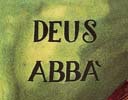 God our Almighty Father wants men to contemplate His face through a sensitive image, through an iconographic image. God our Almighty Father wants men to contemplate His face through a sensitive image, through an iconographic image.
Almighty God is patient and merciful in attracting the hearts of men, these hearts poisoned by the enemy in hell.
Here is the icon of the Father. Who is the Father? He is known by the titles “Deus omnipotens”, Holy and Almighty God and “Abbà – Pater”, Abba, Father: for Jesus of Nazareth and for all His brothers He is Dad: My Dad (Mk 14:36).
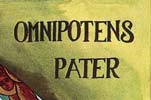
A series of providential circumstances tell us that God the Father desired this icon; it is pleasing to Him and it contains special strength and power.
Moreover, the theological content it expresses is faithful to the traditional doctrine of the Church and to recent private revelations which are considered reliable and authentic and approved by the Church. Therefore the icon, when used in a proper way, can have remarkable spiritual benefits. It is an artistic and elevated form of true contemplative prayer.
My goal is to summarize in the images the wealth of biblical texts. As iconographer, after having studied, with love and passion, the classical traditional form of creating icons, I developed my own personal style. Among my numerous sacred icons, “The Woman clothed with the sun”, “The merciful Jesus”, “The Holy Family” and “Saint Joseph” are well-known.
After a long period of fasting, silence, prayer and suffering, we now have the icon of our Father.
2 – A window through which we can contemplate the divine
The plate is a rectangle. The number of sides (4) is an allusion to the four cardinal points and means that the message which God our Almighty Father wishes to communicate is pointed in all directions. It is, therefore, a message for the whole world.
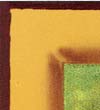 The rectangular shape symbolizes a window on the Divine, which you can open from the earth: that window has an inside gilded frame. The gold symbolizes eternal light. The icon, therefore, is a window through which the divine can be contemplated. It is here that we can contemplate our Father. This definition of the icon is beautiful and evocative! There is a small red border that surrounds the outer frame of the plate. What does that small red border symbolize? It symbolizes the blood Jesus Christ shed on the cross. We can enjoy the beneficial effects of that blood through the gift of the Holy Spirit. On His forehead we see a white shape, like a dove, and its open wings are above His eyebrows. None of the three Divine Persons of the Holy Trinity works without the involvement of the other two. Therefore, it is the icon of the Father, but we immediately notice that the Son and the Holy Spirit are also present. The rectangular shape symbolizes a window on the Divine, which you can open from the earth: that window has an inside gilded frame. The gold symbolizes eternal light. The icon, therefore, is a window through which the divine can be contemplated. It is here that we can contemplate our Father. This definition of the icon is beautiful and evocative! There is a small red border that surrounds the outer frame of the plate. What does that small red border symbolize? It symbolizes the blood Jesus Christ shed on the cross. We can enjoy the beneficial effects of that blood through the gift of the Holy Spirit. On His forehead we see a white shape, like a dove, and its open wings are above His eyebrows. None of the three Divine Persons of the Holy Trinity works without the involvement of the other two. Therefore, it is the icon of the Father, but we immediately notice that the Son and the Holy Spirit are also present.
The three kingdoms of nature are represented in the materials used to illustrate the plate bearing the image.
This is a detail that shouldn’t be neglected, in order to understand the wealth of meaning contained in the icon.
The vegetable kingdom is represented by the wood, while the animal kingdom is represented by the shell powder and rabbit skin glue which are used to produce the plate varnish (finish), and by the egg with which the paint is spread.
The mineral kingdom is represented in the colours, which are metal oxides, ochres and gold.
The plate is like a crib, prepared to receive a mystery, just as God prepared creation in order to receive its king: man, who should have been the king of creation.
In the background of the simple bench on which God our Almighty Father is seated there is an opacity: the colour is almost black, ashen, and not uniform. It is also present on the upper background where there is writing. This colour tells about Eden, the garden of delight, where something like a fog settled down, resulting in a long winter caused by the attitude of the heart of man, who must decide for himself what is good and what is evil.
The space under the bench is also darkened by the fog of man’s sin.
3. – The blue sphere
 In His left hand the Father firmly holds a blue sphere and leans it on His chest. Let us dwell upon it for a moment because it has a fundamental importance in this icon. It is not only the world or the globe. The meaning is very complex, but wonderful. In His left hand the Father firmly holds a blue sphere and leans it on His chest. Let us dwell upon it for a moment because it has a fundamental importance in this icon. It is not only the world or the globe. The meaning is very complex, but wonderful.
After Adam’s sin, the Father drew back, and waited patiently for man, who was freed, to realize his mistake and return to Him.
He waited for many millennia. In the meantime the Father prepared the plan of redemption which His merciful heart had foreseen.
This plan of salvation culminated with the coming of the Incarnate Word, the Son made man who, with His Passion and Death, allowed the Holy Spirit to communicate Himself to man again.
With Jesus’ “It is finished” on the cross, the plan which was so dear to the heart of the Father can finally continue: the divinization of man and through man a new creation.
This is what the blue sphere expresses: it is the Father’s plan of love which He rests on His heart and holds firmly in His hand. The blue points out that the plan, its execution and its fulfilment are divine works.
The Alpha and Omega which fill the entire sphere refer to the Word, the beginning and end of all things. In fact: “Everything was made through Him and in view of Him” (Jn 1:3).
A golden cross stands above the sphere. The cross is the throne of the Immolated Lamb, who has given Himself for the salvation of all men.
The gold symbolizes eternity. The Fathers of the Church tell us that “the cross was written in the Heart of God the Father from all eternity”.
How full of meaning is that blue sphere which the Father gently holds with His left hand!
 4. – The figure of the Father fills the whole icon 4. – The figure of the Father fills the whole icon
It is in a perfectly frontal position, to indicate His willingness to reveal Himself to all who wish to know Him.
The figure is set in a golden almond drawn around His shoulders. Through it you enter the open skies.
The blue skies are inhabited by the heavenly spirits, who are closest to the throne of the Most High.
The 12 quivering flames represent all the angelic powers, among whom we can see the outline of the seraphim, i.e., the spirits burning with love: six to the right and six to the left.
The seraphim contemplate with wonder the extraordinary and unpredictable action of God the Father, who operates continuously through His infinite love and endless mercy.
The number 12 symbolizes “responsible authority”: like the 12 apostles, patriarchs and the stars which adorn the Woman clothed with the sun, etc. The 12 seraphim not only contemplate, but are also faithful messengers and do the Father’s will.
5. – The face
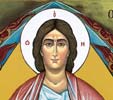 Philip said to Jesus: “Lord, show us the Father and that will be enough for us”. Jesus answered: “Philip, whoever sees me, sees the Father” (Jn 14:8-9). Philip said to Jesus: “Lord, show us the Father and that will be enough for us”. Jesus answered: “Philip, whoever sees me, sees the Father” (Jn 14:8-9).
Jesus meant that He worked like the Father and always did the Father’s will…
But how can we represent the face of Him who cannot be represented?
Traditional Western iconography has always represented the Father as an imposing old man - kind, solemn, with a white flowing beard.
But the beard is an attribute of a man of flesh and blood, a sign of his virility. The white beard expresses the aging of the body, it is a sign of the corruptibility of the flesh.
Such features cannot be attributed to the figure of God the Father, who is pure spirit. Andrey Rublev, a holy monk and iconographer, was well aware of this when in 1420 he produced the famous icon of the Holy Trinity. Therefore, this icon inspired me for the detail of omitting a beard and also for the colours of the tunic and mantle.
Here, then, according to the canons of Eastern iconographic tradition, is that majestic face which inspires peace, strength and serenity.
The head is surrounded by a white halo, signifying glory. It is marked by the Greek initial letters (omicron, omega, eta, ni) of the name revealed by God to Moses on Mount Horeb: “I am who am” (Ex. 3:14): I am the reason for existence.
The black hair signifies the “divine darkness” or mystery that is inaccessible to the human mind. It opens like a veil in the middle of the forehead, as the sky opens to show the light.
The hair is covered by golden “strigils”, like the veil of the Holy of Holies in the Temple of Jerusalem, which was rent from top to bottom when the heart of Jesus was pierced by the lance, when enmity with God was removed and man was once again able to contemplate God’s countenance. This is the meaning of the black and golden hair.
The small lips are shown in the act of breathing the live-giving Spirit. This is also manifested in the bulging neck.
The eyes look at all with love and tenderness. They await a response from all of us.
Behind the figure there is a glimpse of the third sky, the place of eternal happiness to which God wishes to lead us all.
6. The tunic and the mantle
 The blue tunic and the red mantle point out who God our Almighty Father is for us. The blue of the tunic signifies divinity. The red mantle expresses God’s wisdom and ardent love. The blue tunic and the red mantle point out who God our Almighty Father is for us. The blue of the tunic signifies divinity. The red mantle expresses God’s wisdom and ardent love.
These colours are clear, transparent and almost fluorescent, as if they are diffused with the light of the Transfiguration.
The very ample and imposing mantle means acceptance and the edge, which touches the earth, wants to point out to all people that if they want, they can cling to His mantle to receive the Holy Spirit. The mantle itself which is accepted can be a sign of a precious inheritance which is accepted, in order to cherish it faithfully. Like Eliseus…who, with great appreciation, received Elijah’s mantle: a sign of his spiritual inheritance (1 Kings 19:19).
7. – Significant details
Some other very significant details are: the bench, the two pillows, the right hand, the sceptre, the royal crown and the position of the feet.
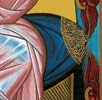 a) The bench on which the Almighty Father is sitting is very simple, because He desires that we sit beside Him without hesitation or fear. However, because of His Divine presence, although of modest design, it is covered with rays of gold. a) The bench on which the Almighty Father is sitting is very simple, because He desires that we sit beside Him without hesitation or fear. However, because of His Divine presence, although of modest design, it is covered with rays of gold.
b) The two pillows point out that God (the blue pillow on the left) and man (the red one on the right) can converse together, in the same place, like at the beginning of creation.
 c) The right hand is raised in an expansive attitude of blessing because, like a good Father, He does not want to judge the world, but save it, confirming the mission entrusted to His Son. In fact, Jesus said: “Go then and learn what this means: I desire mercy and not sacrifice. For I have not come to call the righteous, but sinners” (Mt 9:13). c) The right hand is raised in an expansive attitude of blessing because, like a good Father, He does not want to judge the world, but save it, confirming the mission entrusted to His Son. In fact, Jesus said: “Go then and learn what this means: I desire mercy and not sacrifice. For I have not come to call the righteous, but sinners” (Mt 9:13).
 d) The sceptre, the symbol of judgement, has been placed on the ground between His feet: the Father only wishes to exercise mercy. d) The sceptre, the symbol of judgement, has been placed on the ground between His feet: the Father only wishes to exercise mercy.
e) The royal crown, placed beside the sceptre by the right foot, is an invitation not to be afraid to approach Him. He wants to remove the uneasiness in us and wants to draw us to Him and receive us on His Fatherly knees.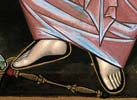
f) Although the Father is sitting, His feet are in the position of someone who is about to depart. The Father wishes to come towards us and stay with us. They too are surrounded by the halo of sanctity. The black that surrounds the feet is not a sign of the sandals or shoes; it is a sign of the “divine darkness”: a sign of the infinite wealth and wisdom of God, whose knowledge is never ending.
What a wealth of theological contents and how beneficial for our devotion and our spiritual life!
This icon is something to be contemplated, not studied! It was born in prayer. It must be used in prayer and for prayer. It is thus a powerful aid in prayer and union with God.
It brings to life, or makes, present, the divine person or saint who is represented in the icon. In this case it makes our Father alive and present.
May this icon help us, then, to achieve a filial and affectionate encounter with God, our Almighty Father. |
